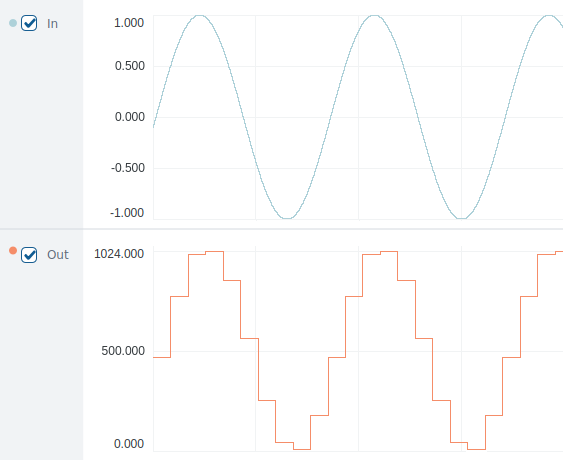ADConverter Class
(Automation::ADConverter)The ADConverter can be used to convert the input analog signal values to corresponding digital value. More...
| Header: | #include <ADConverter> |
| Inherits: | CDPOperator<T> |
Public Functions
| ADConverter(const CDPPropertyBase &in) |
Reimplemented Public Functions
- 18 public functions inherited from CDPOperator
- 18 public functions inherited from CDPOperatorBase
- 50 public functions inherited from CDPBaseObject
- 27 public functions inherited from CDP::StudioAPI::CDPNode
- 22 public functions inherited from CDP::StudioAPI::ICDPNode
Additional Inherited Members
- 1 public variable inherited from CDPOperatorBase
- 1 static public member inherited from CDPBaseObject
- 1 protected function inherited from CDP::StudioAPI::CDPNode
- 8 protected variables inherited from CDPOperator
- 5 protected variables inherited from CDPOperatorBase
- 10 protected variables inherited from CDPBaseObject
Detailed Description
The ADConverter can be used to convert the input analog signal values to corresponding digital value.
Arguments
| Name | Description |
|---|---|
| In | The analog input value |
| InputRange | Maximum value the analog input can have |
| Bipolar | Set to true when the input value varies between -InputRange ... +InputRange. Set to false when the input value varies between 0 ... +InputRange. |
| OutputRange | Maximum value the digital output should have when the analog input is at its maximum value |
| Out | The converted digital value |
| OutOfRange | Is set to true when the input value is out of range |
Note: Setup and hold frequency of the converter depends of the component frequency the ADConverter is residing in. So you can adjust the setup and hold frequency of the converter by adjusting corresponding component frequency (by fs property of the component).
When operator is used inside a signal its default input is automatically tied to signal's InternalValue or previous operator's output. Its default output is automatically tied to next operator's input or to signal's Value. See also CDP Operator Usage In CDP Signals.
Example
Below is an example plot of sinusoidal analog input signal (cyan) and the same signal with ADConverter(InputRange=1, OutputRange=1024, Bipolar=true) applied (orange).
Note, that in this example ADConverter is in low frequency component so values are read and converted using lower frequency than the original analog signal changes:

Actual Processing Code of the ADConverter
unsigned int ADConverter<double>::Process() { if (!m_inputRange || !m_bipolar || !m_outputRange || !m_outOfRange) return STATUS_ERROR; double inRange = (double)*m_inputRange; unsigned int outRange = (unsigned int)*m_outputRange; if (inRange <= 0 || outRange == 0) { GetParent()->ReportConfigurationFault(this, "InputRange and OutputRange must be greater than zero"); m_faultReported = true; return STATUS_ERROR; } bool bipolar = (bool)*m_bipolar; double out = rint(((double)m_input) / inRange * outRange / (bipolar ? 2 : 1) + (bipolar ? (outRange / 2) : 0)); if (out > outRange) { *m_outOfRange = true; out = outRange; } else if (out < 0) { *m_outOfRange = true; out = 0; } else *m_outOfRange = false; m_output = out; if (m_faultReported) { GetParent()->ClearConfigurationFault(this); m_faultReported = false; } return STATUS_OK; }
See also Argument.
Member Function Documentation
ADConverter::ADConverter(const CDPPropertyBase &in)
Default constructs an instance of ADConverter.
[override virtual] void ADConverter::Configure(XMLPrimitive *operatorXML)
[override virtual] unsigned int ADConverter::Process()
Get started with CDP Studio today
Let us help you take your great ideas and turn them into the products your customer will love.